 Most interchange entrance ramps have a dangerous "yield" configuration (right)
with no acceleration lane, instead of a safe "merge" design.
Most interchange entrance ramps have a dangerous "yield" configuration (right)
with no acceleration lane, instead of a safe "merge" design.The I-69 project started off badly, and in the time since 08/01/2018, it has gotten much worse. There are dangerous places on the highway where crashes are more likely because safety was ignored. It takes a long time to either follow the highway or to get from one side of the highway to the other. Also, it takes emergency vehicles much longer to reach a location near the highway, and some must cross county lines to get to certain places in violation of insurance requirements.
"And they tell me, over and over and over and over again... that you can't get there. The road is under construction."
Here is the status of the project as it was on 05/21/2018:
 Most interchange entrance ramps have a dangerous "yield" configuration (right)
with no acceleration lane, instead of a safe "merge" design.
Most interchange entrance ramps have a dangerous "yield" configuration (right)
with no acceleration lane, instead of a safe "merge" design.Here is the history of the problems with the project:
- These constraints caused the project to take longer and cost more.
- This caused major delays in construction of the Vernal Pike, Fullerton Pike, and Liberty Church Road overpasses.
 They initially closed or restricted Fullerton Pk, Tapp Rd, Second St, Third St,
Vernal Pk, Kinser Pk, Sample Rd, and Liberty Church Rd simultaneously.
They initially closed or restricted Fullerton Pk, Tapp Rd, Second St, Third St,
Vernal Pk, Kinser Pk, Sample Rd, and Liberty Church Rd simultaneously.These constricted traffic to the point that people often can't get to where they are going without hours of delay.
- The Third Street signals restrict westbound cars. The bridge is full when the signal turns green.
- The bridge allows 4 cars can go, and then the signal turns red.
- The signals were not retimed as the city promised they would be.
Here are the causes of some of the worst problems:
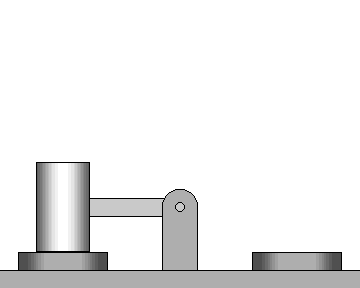 Democrats opposing all private funding of government projects badmouthed the bonds sold
to build I-69.
Democrats opposing all private funding of government projects badmouthed the bonds sold
to build I-69.
- This downgraded the bonds so not enough money was raised.
- The Democrats got their wish. They ruined the private funding and delayed the project.
- Democrats were against building I-69 from the beginning, but they were outvoted.
- When they couldn't stop the project, they made rules that would cause the project to not make the completion date.
- Democrats demanded that the state must take over the project.
- Once the state took over, politicians demanded that the construction be finished as soon as possible, causing many closings and restrictions.
- Where Democrats have control, they are making this project inconvenience as many people as they can.
There must be a lane closed and filled with drum barricades or a New Jersey barrier between any moving traffic and any of the following:
- These rules caused the dangerous on-ramp "YIELD" configuration to be used instead of the much safer "MERGE" configuration.
- They also jammed up more traffic.
 Lanes were not changed back to the MERGE configuration even though lanes were available
for several days with no work present.
Lanes were not changed back to the MERGE configuration even though lanes were available
for several days with no work present.
They didn't want to pay workers extra for the time and labor needed to change the configuration between YIELD and MERGE entrances:
- This caused the dangerous on-ramp "YIELD" configuration to be used instead of the much safer "MERGE" configuration.
- Many contractors don't understand the safety difference between the different kinds of entrance ramp treatments.
- Contractors use the "YIELD" configuration instead of the much safer "MERGE" configuration to save money and labor.
- Use of the "YIELD" configurations makes selfish drivers on the freeway fail to let in entering traffic.
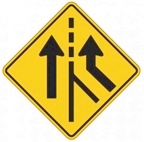

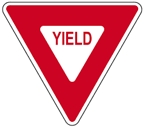
- The sign types are (left to right) ADDED LANE, MERGE, and YIELD. They must never be used together.
- Contractors don't want to pay workers for labor needed to change the signs for each configuration.
- They don't want to pay for a larger sign inventory.
- See Merging Traffic Safely.
- None of these use the same parts. This makes changing the signs for each configuration expensive.
- Using the YIELD configuration in merges with and without acceleration lanes makes it
more dangerous.
Drivers don't know in advance whether an acceleration lane is there
or not, since all of the ramps have YIELD signs.
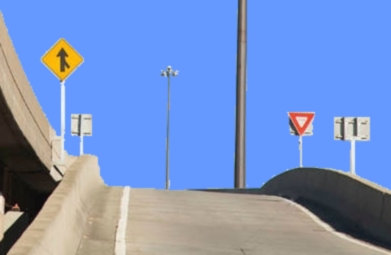 Contractors left misleading ADDED LANE, MERGE, or YIELD signs in place, even though they
caused hazards:
Contractors left misleading ADDED LANE, MERGE, or YIELD signs in place, even though they
caused hazards:
- Each of these signs misleads when used with the wrong configuration (right image).
- They didn't want to pay workers extra for the time and labor needed to do it right.
- This caused the dangerous on-ramp "YIELD" configuration to be used instead of the much safer "MERGE" configuration.
- The misleading signs made motorists think a YIELD or MERGE maneuver was not needed when in fact it was.
- The same signs were left in place when they changed from YIELD to MERGE or from MERGE to YIELD.
They didn't want to pay workers extra for the time and labor needed to do it right.
They didn't consult the Manual of Uniform Traffic Control Devices (MUTCD) before using the signs and devices.
- They didn't remove the covers when they opened the lanes again.
- The signal wasted time by allowing only one movement to go during the southbound left turns.
Here are the changes after 05/21/2018:
 All interchange entrance ramps still have a dangerous "yield" signage,
even though they now have acceleration lanes. The contractors don't want to have to
change the signs when they have to close an acceleration lane.
All interchange entrance ramps still have a dangerous "yield" signage,
even though they now have acceleration lanes. The contractors don't want to have to
change the signs when they have to close an acceleration lane.
- Traffic backs up to Bloomington Hospital.
- Traffic backs up into the downtown area.
- The traffic signals on Third Street were not retimed to alleviate this backup as promised.
- The northbound entrance is still closed, but traffic can use the intersection access to the east leg of Sample Road and some frontage roads.
- The northbound entrance opened 07/14/2018.
On 01/21/2018, the northbound side opened. Traffic is restricted to one lane in each direction on its own roadway.
At the same time, the northbound ramps for Liberty Church Road opened. The southbound ramps are still closed for drainage work.
- But it was supposed to already be done by then.
| Are These Protected/Permissive Left Turn Signals Allowed (with one left turn lane and two thru lanes)? | ||
| NO - Circular green over left turn lane | YES - Circular green over left thru lane | YES - Flashing Yellow Arrows |
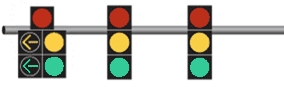 |
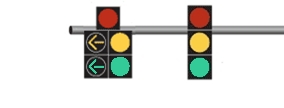 |
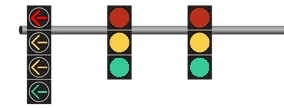 |
- The traffic signal at Second Street and the southbound ramps of IN-37 and I-69 has circular greens over the left turn lanes (as in left diagram).
- A circular green is not allowed to be in a signal face placed over or in front of an exclusive left turn lane (should be as in center diagram).
- Traffic signals at Second Street and Liberty Drive and at Second Street and Basswood Drive also have circular greens over exclusive left turn lanes that violate the MUTCD.
- Traffic signals on Third Street at Gates Drive, at Wynndale Drive, and at the southbound IN-37 ramps also have circular greens over exclusive left turn lanes.
- UPDATE 08/08/2018: The signal at Second Street and Basswood Drive now has Flashing Yellow Arrows. Only the temporary construction signals violated the MUTCD.
- UPDATE 08/10/2018: The signals at the six intersections with the wrong 5-section faces
now have Flashing Yellow Arrows.
The temporary construction signals violated the MUTCD to reduce the
amount of labor needed to convert them.
- UPDATE 08/13/2018: The signal on the Sam's Club driveway on the Second Street
interchange has a flashing yellow arrow face and two 3-section thru signal faces.
This violates the MUTCD because there is only one lane open and the
left green arrow shows with circular red on a single-lane approach.
- They removed the originally promised auxillary lanes between Second Street and Third Street and also the northbound lane between Fullerton Pike and Tapp Road.
- The already existing auxillary lanes between Second and Third were removed.
-- This is going to be a nuisance for drivers who in the past used the
auxillary lanes to connect between Second and Third.
-- If the auxillary lanes had been deemed necessary before the
construction, why aren't they necessary now?
AUTION
TAUTION
PAUTION
NEW
TRAFFIC
PATTERN
The left column of letters is not changing with the rest of the sign.
It was fixed, but a week later, it said:
CAUTION
CAUTION
CAUTION
C NEW
CRAFFIC
CATTERN
These patterns have appeared, and then were fixed over and over again.
Here are the changes after 09/01/2018:
 All interchange entrance ramps still have a dangerous "yield" signage,
even though they now have acceleration lanes. The contractors don't want to have to
change the signs when they have to close an acceleration lane.
All interchange entrance ramps still have a dangerous "yield" signage,
even though they now have acceleration lanes. The contractors don't want to have to
change the signs when they have to close an acceleration lane.
- But it was supposed to already be done by then.
- I-69 still has lane closures in the Bloomington area, and is still only one lane in each direction north of Sample Road.
- The vehicle detectors for the Second Street and Third Street interchanges have not yet been installed, and signals are still pretimed.
- The right turn arrows for the turn out of the Sam's Club are not connected yet.
- Lane closures continue.
- I-69 route markers and mileposts are being placed and I-69 shields on direction signs are being uncovered.
- I-69 is still only one lane in each direction north of Sample Road.
- The vehicle detectors for the Second Street and Third Street interchanges have not yet been installed, and signals are still pretimed.
- The right turn arrows for the turn out of the Sam's Club are not connected yet.
- This is dangerous.
- Similar unsigned lane drops appeared on Second Street.
- There was a notice in the newspaper for lane drops on Second Street, but this does not warn strangers to the area.
- Some ramp lanes are still closed.
- Some traffic signals are still not fully actuated.
- Some rebuilding of the IN-46 interchange is scheduled for spring 2019.
- Thanks to legislative stupidity, trucks over 13 tons are restricted to 65 mph. This causes more passing conflicts and reduces highway capacity.
- Thanks to the former stupid political power of Ted Kennedy, urban parts are 55 mph. This is a political speed limit, not a necessary speed limit.
- Some of the speed limit signs in the rural area have been lowered to 55 mph.
Here are the changes after 12/01/2018:
 Some interchange entrance ramps still have a dangerous "yield" signage,
even though they now have acceleration lanes. The contractors don't want to have to
change the signs when they have to close an acceleration lane.
Some interchange entrance ramps still have a dangerous "yield" signage,
even though they now have acceleration lanes. The contractors don't want to have to
change the signs when they have to close an acceleration lane.- The sign panels had not yet been changed.
- The panels were changed before 12/31/2018 when the page author saw the new panels.
Many ramps still have barrels along one side.
Here are the changes after 03/18/2019:
Here are the changes after 06/01/2019:
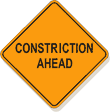 The pavement on the entire west IN-46 overpass approaches at I-69 will be totally replaced.
The pavement on the entire west IN-46 overpass approaches at I-69 will be totally replaced.
The project was to run from 06/01/2019 to 11/21/2019.
- Note: An unofficial detour is to use Curry Pike instead of going to Spencer.
- Note: An unofficial detour is to go east on IN-46 and make a U-turn at Kinser Pike.
- Note: They finally marked the IN-45 detour.
- Note: An unofficial detour is to go east on IN-46 and make a U-turn at Kinser Pike, and then take the northbound ramp.
- Note: An unofficial detour is to use Curry Pike and IN 48 for any movement.
- Note: An unofficial detour is to go east on IN-46 and make a U-turn at Kinser Pike, and then take the northbound ramp.
* Official detours must use actual state and US highways, not other surface streets. Turnbacks at Interchanges are an exception.
IT WOULD HAVE BEEN IMPOSSIBLE FOR A SELF-DRIVING CAR TO SUCCESSFULLY NAVIGATE THIS CONSTRUCTION ZONE.